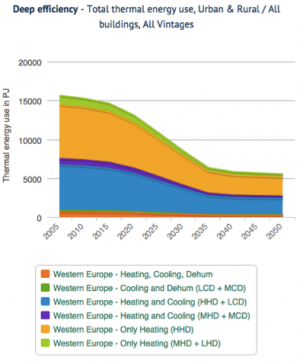New Tool for Building Energy Performance Scenarios (BEPS): Making the Black Box Transparent
GBPN is moving forward in making building data transparent and publically available as well as engaging with various organizations into knowledge exchange.
In 2012 GBPN conducted a comprehensive study together with the Centre for Climate Change and Sustainable Energy Policy (3CSEP – Central European University) focused on the scenario analysis of building energy use and related CO2 emissions and mitigation potential of energy efficiency improvements.
Today, the GBPN launched the new Building Energy Performance Scenarios (BEPS) Tool, which gives the opportunity to access, through a user-friendly interactive online interface, all key input data, assumptions, and scenario results for building energy use worldwide that were behind this sophisticated analytical work.
The BEPS tool offers a wide range of the opportunities to analyse and visualize building energy use data under three different scenarios (deep, moderate and frozen), depending on the ambitiousness of policy decisions and technology choices. Let’s now look at the main parameters that can be used.
Building types
The BEPS tool gives the opportunity to analyze building energy use in a number of buildings types. Different types of visual outputs can be used for this analysis depending on your goals and interests. Have a look at the example we created for South Asia. The area chart shows the contributions of different building types to the total thermal energy use for a specific year, while the bar chart demonstrates building energy use for different building types in 2025 under different scenarios.

Vintages
Vintages are the key for understanding the difference between the scenarios. In the example for North America, we can see that under the moderate scenario that there is no advanced buildings and that the energy use by 2050 is much higher than under the deep scenario. In the deep scenario, by 2050, most of the buildings are constructed and renovated to a very high level of building energy performance (advanced new and advanced renovated buildings), which leads to significant energy savings.


Scenarios
Scenarios in the BEPS tool demonstrate different levels of ambition for policy and technology improvements related to energy efficiency. As shown in the two graphs below, there is a significant energy saving potential by 2050 under the deep scenario for the Former Soviet Union and Centrally Planned Asia, which can be lost to a large extent if these regions follow the moderate or frozen paths.



Climate zones
A comprehensive climate typology developed by 3CSEP for the GBPN reflects different energy needs for space, heating, cooling, and water heating taking into account various climatic parameters. The BEPS tool allows the visualization of energy use for different climate zones for each region, scenario and end-use, as shown in the beside graph for six climate zones in Western Europe.
Related News
Related Report Bundles
Share This Story, Choose Your Platform!
Stay in touch with how we’re transforming the buildings sector
GBPN runs innovative building policy reform programs in key regions around the world that aim to tackle the climate emergency by decarbonising the buildings sector. Stay up to date with our newsletter.
Stay in touch with how we’re transforming the buildings sector
GBPN runs innovative building policy reform programs in key regions around the world that aim to tackle the climate emergency by decarbonising the buildings sector. Stay up to date with our newsletter.






